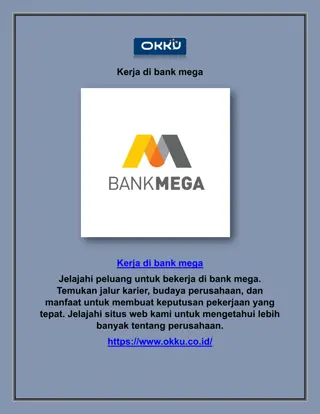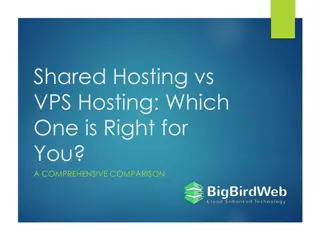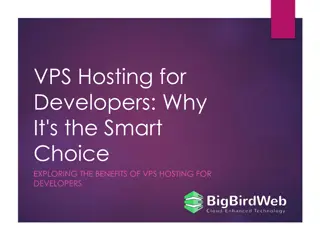Impact of Hosting Mega Events on Regional Economy
Hosting mega events can bring various benefits to a region, including improved infrastructure, increased tourism, higher sports participation, and signaling readiness for foreign investments. However, hosting such events also requires substantial investments and long-term planning to ensure sustainable growth. Research on events like the FIFA World Cup in South Africa shows both the potential for economic gains and the challenges of managing costs effectively.
Download Presentation

Please find below an Image/Link to download the presentation.
The content on the website is provided AS IS for your information and personal use only. It may not be sold, licensed, or shared on other websites without obtaining consent from the author.If you encounter any issues during the download, it is possible that the publisher has removed the file from their server.
You are allowed to download the files provided on this website for personal or commercial use, subject to the condition that they are used lawfully. All files are the property of their respective owners.
The content on the website is provided AS IS for your information and personal use only. It may not be sold, licensed, or shared on other websites without obtaining consent from the author.
E N D
Presentation Transcript
Influence of Sport Mega Events on the Economy of a Region Alex Krumer- University of St. Gallen 17/11/2017
What are possible gains of hosting a Mega- Event? General infrastructure that are politically difficult to provide without the strict deadline of an opening ceremony (roads, airports, etc.). An increased number of tourists after the event. Promotion of a higher sports participation (health). New stadiums. Signal to investors that a country is ready to welcome foreign investments. Putting a country on the map (politically and economically).
What are possible gains of hosting a Mega- Event? But: There are no gains without (large) investment!!!
General infrastructure Many hosts of mega-events are able to use their hosting as a catalyst to make investments that would not necessarily be available to them at other times. Roads, hotels, redevelopment increased security. of old or unused buildings, The potential benefits from investments in a city s infrastructure for the hosting of a mega-event make it difficult to judge the financial success of hosting such an event. These costs can contribute to the host ex post for as long as fifty years after the event has taken place (Gratton et al., 2006, Soc Rev)
Tourism For example, Peeters, Matheson and Szymanski (2014, J Afr Econ) investigated the effect of the 2010 FIFA World Cup on tourism in South Africa. The authors found a substantial increase of around 220,000 visitors from non-Southern African Development Community (SADC) countries during the event. Taking into account the possible dynamic and legacy effects over the following months and years, this number increases to around 300,000 extra arrivals (the initial prediction was 483,000 visitors).
Tourism The 2010 FIFA World Cup entailed $3.9 billion in expenses borne by South Africa ($1.3 billion in stadium construction costs) (Du Plessis and Maenning, 2011, Development Southern Africa). This implies that South Africa spent more than $13,000 per visitor. Even when the authors take a very conservative view and only consider the cost of stadium construction, the estimates still point to a cost of over $4,400 per additional non-SADC visitor. But obviously, what matters is that there will be a sustainable growth.
Tourism Mitchell and Stewart (2015, App Econ) investigated the impact of several mega-events on tourism over a longer period of time. Olympic Games (Seoul 1988, Barcelona 1992, Sydney 2000, Athens 2004 and Beijing 2008) FIFA World Cup (France 1998, Japan and South Korea 2002, Germany 2006) They also compared these countries to the most similar countries as possible over the same period of time. They found a very little positive impact from these events.
Tourism The Beijing Olympics did not seem to have any effect on Chinese tourism (but still higher compared to India over the same period of time). The Seoul 1988 Olympics showed a significant increase in tourism. There is no evidence of any changes for either Australia (2000) or Spain (1992). For the 1998 French World Cup, where they looked at tourist prices, there was a significant increase in the trend after the event but this was cancelled out by a decrease in the intercept (while the comparable country of Germany was not significantly affected).
Tourism The World Cup in Germany (2006) showed a significant increase in hotel stays for the first month in which matches (mostly the group stage) were held, but not the second (knockout stage). However, France showed a significant increase in tourist prices during the second month. For the 2002 World Cup, held jointly by Japan and South Korea, there was a significant increase in tourist numbers for Japan during the event and a smaller, but still significant decrease in South Korea.
The effect of SARS outbreak (as example on negative effect on tourism)
Higher sports participation According to Veal, Toohey and Frawley (2012) there may have been a positive effect on adult sports participation after 2000 Olympic Games. Weed, Coren and Fiore (2009) argued that hosting Mega- Events does not naturally lead to an increase in sporting participation, and that the organizing committee should focus on ways to ensure that this legacy does occur. In their comprehensive review on developing a physical activity and health legacy from the London 2012 Olympic Games, Weed, Coren and Fiore ( 2009) provide additional results on the effect of hosting Mega-Events on differennt social activities (sports participation, crime, health indices, etc.).
Higher sports participation Frawley and Cush (2011) showed an increase in registration in Australian junior rugby following 2003 Rugby World Cup that took place in Australia.
White elephants One of the requirements of the organising committees is to build big stadiums (30,000-40,000 or more). In many cases such stadiums are labelled as unsustainable, financially-burdening white elephants . Siegfried and Zimbalist (2000, J Econ Persp) found no statistically significant correlation construction and positive long-term economic development in the USA. between sports facility
White elephants According to Siegfried and Zimbalist (2000, J Econ Persp) there are three criticisms of the economic impact of building new stadiums Substitution effect- spenders at the stadium would have spent money elsewhere, implying that spending in the stadium is not in addition to the normal levels of spending, but is merely replacing spending that would otherwise be taking place elsewhere in the economy. Leakages- money leaves the local economy. For example, suppliers to the facility may be based outside of the area, while large proportions of teams revenues are spent on salaries for their athletes, who are unlikely to live in the local economic area. Budgetary impact- spending by authorities on the stadiums are often larger than the revenues gained.
White elephants Bason, Cook and Anagnostopoulos (2015) report that the Cape Town stadium with the capacity of 55,000 seats had on average 6,258 spectators for home attendances during the 2014/15 season. Only two major non-sports event took place there in 2015 (concert by Michael Buble and British band One Direction). Stadium is losing approx. 440,000 Euros p.a. in maintenance costs alone (GDP per capita in South Africa is 4,523 Euros p.a.). Similar situation occurs in Durban stadium with the capacity of 54,000 seats had on average 6,100 spectators for home attendances during the 2014/15 season. Only one major non-sports event took place there in 2015 (concert by American artist Chris Brown)
Will Ekatirenburg Arena become another white elephant? The announced gross capacity of Ekatirenburg Arena is 35,696 visitors (source: FIFA website). Average attendance of FC Ural in the last 4.5 seasons (including 9 matches of 2017-18 season) is only 7,437 visitors with only one match was sold out (the current capacity is 13,000 seats) website) (source: transfermarkt
Some thoughts Russia is a large country extending across northern Asia and Eastern Europe. It is worthwhile to make an effort to participate in Asian Cups (only clubs) in addition to the current participation in the European Cups. If the AFC (Asian Football Confederation) and the UEFA (Union of European Football Associations) agree, than it is possible to organise two separate Russian leagues (Europe and Asia), such that each league will send teams to the UEFA (Europe) and AFC (Asia) club competitions.
Some thoughts This step is likely to increase the participation of young people in football. This is likely to increase the number of tourists from Asia (if Russian clubs qualify to the advanced stages of the Asian cups). This is likely to increase the usage of Ekatirenburg Arena (more games? better performance?). However, the usual question is whether this expansion will be financed by public or private money?
Some thoughts It is also worthwhile to advertise local unique places during the World Cup that may attract foreign and (probably mainly) Russian visitors. For example, promotion of the local University during the games. Azov sea as an example. The unique location as a border between Europe and Asia may also be attractive for tourists (may be some tours during the event).























